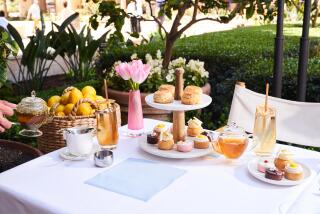AROUND HOME : Notes on Painted Tin, Tiling and Big Napkins : Painted Tinware
- Share via
PAINTED TINWARE I Sat once decorative and useful, both primitive and sophisticated, and it is quite at home in decors ranging from high style to high tech. For the most part it is far less expensive than porcelain or lacquer work, the techniques it imitates with such boldness and imagination.
The technique is a simple one: Sheet iron is coated with tin and painted by hand. Most of the tinware found today is of 19th-Century origin. By far the most popular items for collectors are trays of all kinds--English, French and American, in particular. The spectrum is a broad one, and collectible items range from sophisticated European work to primitive folk pieces made in rural America.
The English produced an enormous quantity of urns, kettles, tea caddies, document boxes and such special objects as chestnut servers, cruet frames and plate warmers. Backgrounds--painted in green, red, brown, yellow or black--were often ornamented with Chinese motifs. Take, for example, the typical English Regency tray in black and gold, with the chinoiserie decoration so popular during that period. The technique of imitating Oriental lacquer with paint and varnish was perfected at Pontypool and Birmingham about 1760.
As in so many other areas, elegance was the province of the French, and in their hands painted tinware reached a degree of high sophistication. In fact, tinware in general is often called by its French name, tole. A favorite French background color is vermilion, decorated with classical motifs in gold, in the Empire manner, and found on hot-water urns, vases, wreaths, lamp shades, wall sconces and cachepots.
In design, American tinware is influenced by English pottery of the same period (exported to America in great quantity), itself derived from Oriental models. Painted tinware appealed particularly to country dwellers, and they decorated their simplest utensils with flowers and animal and other designs. The items usually found are coffeepots, sugar bowls, teapots, mugs, deed boxes (still used today) and, always, trays. Perhaps the most handsome American painted tinware comes from Pennsylvania (circa 1820) in which the use of black and yellow on a red background clearly suggests lacquer. Also of interest are gaily decorated tin boxes used in retail shops between 1880 and 1930 to package goods.
Look for painted tin at Baldacchino, Quatrain and Renee Talbot in West Los Angeles; Country Pine and Design and Richard Gould in Santa Monica; Norma Dee in La Jolla (Americana); Wild Goose Chase in Santa Ana (Americana); Brackett’s Antiques and Pasadena Antique Center in Pasadena , and Connoisseur and Mission Antiques in San Diego.
